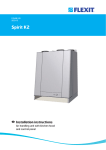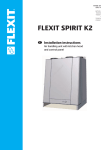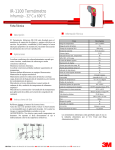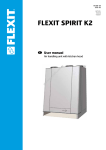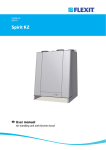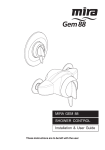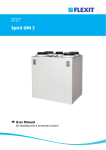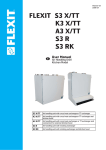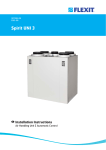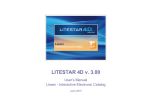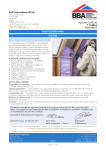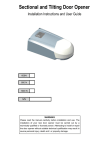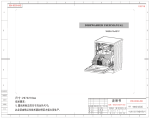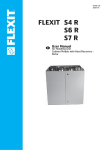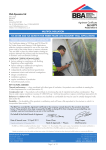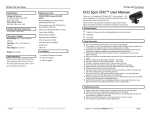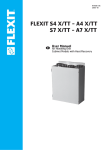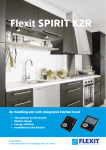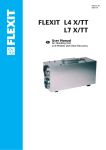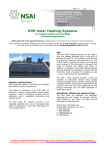Download Operating Instructions (E)
Transcript
102608E-01 2009-10 Flexit SPIRIT K2 R User manual and installation instructions Air handling unit with kitchen hood Contents User instructions 1 2 3 4 Functional Description 1.1 Heating element 1.2 Operation of kitchen hood Cleaning/Maintenance Maintenance table Troubleshooting 4 4 4 5, 6, 7 8 9 Installation instructions 5 6 7 8 9 10 11 12 13 14 15 Installation/Preliminaries 5.1 Inspection/Maintenance 5.2 Space Required 5.3 Location requirements 5.4 Recommended sound attenuation for wall-mounting I nstallation of Flexit SPIRIT K2 R 6.1 Installing the volume hood Connection of unit and electrical work 7.1 Connection of unit 7.2 Electrical work 7.3 Automatic Control 7.4 External components Sizes/Physical Dimensions 8.1 Dimensioned sketch General Drawings and System Drawings Capacity and sound data 10.1 Capacity diagram, sound data, specifications - K2 R AC 10.2 Capacity diagram, sound data, specifications - K2 R EC Technical data Adjusting the Kitchen Hood 12.1 Forced Ventilation Adjustment Curves 13.1 Forced ventilation Final checks/first use 14.1 Final Checks 14.2 First use EC Declaration of Conformity 10 10 10 10 11 12 12 13 13 13 13 13 14 14 15 16 16 17 18 19 19 20 20 21 21 21 22 Our products are subject to continuous development and we therefore reserve the right to make changes. We also disclaim liability for any printing errors that may occur. 2 ! Important Safety Instructions: It is the installer's responsibility to carry out a full safety and function assessment of the appliance To reduce the risk of fire, electric shock or injury, read all the safety instructions and warning texts before using the appliance. • This unit is only designed for ventilation air in buildings. • It must not be used to extract combustible or flammable gases. • Remove the power plug before commencing any service and maintenance work. • Before opening the door, current to the unit must be turned off and the fans must have had time to stop (min. 3 mins.). • The unit contains heating element which must not be touched when it is hot. • The unit must not be operated without the filters being in place. • Do not cook substances which could catch fire under the ventilator. • Do not leave a saucepan or frying pan containing oil or grease unsupervised. • Follow the instructions in the user manual. To maintain good indoor air quality, comply with regulations and to avoid condensation damage the unit must never be stopped apart from during service/maintenance or in connection with an accident. Symbols Used These products bear a number of symbols used for labelling the and user 6 actual product and in installation 5 documentation. 4 3 2 HIGH VOLTAGE D DANGER! DO NOT TOUCH 14,0 SAFETY SWITCH C 35,0 ! CAUTION When a text bears this symbol, it means that personal injury or serious damage to the equipment may result if the instructions are not followed. NB! When a text bears this symbol, damage to equipment or a poor utilisation ratio may result if instructions are not followed. B Type: Material: EXAMPLE OF NIPPLE LOCATION (shown as right-hand model) A Description 3 6 Opaque Glossy vinyl According to IEC/EN 60335-1 Colour: White Adhesiv: Note that the product is not designed for operation byPermanent person with impaired physical, motor or mental abilities. The product must also not be used by persons who lack experience or knowledge, unless they have received guidance or instructions in operating the product safely by a person responsible Projection Date Drawn Scale for safety. 24.03.2009 leif Approved Status 2:1 5 4 3 Etikett sikkerhetsbryter Project G2-1A Stocknumber 102732 2 Replace For user 1 Functional Description See page 15 for component description. Cold outdoor air passes through one half of the rotor (HR-R), while warm extract air passes through the other half, without the two mixing. Using this principle, a large proportion of the heat in the extract air is transferred to the supply air the heat store principle (see system sketches). If the outdoor temperature is extremely low, a thermostat-controlled heating element (EB1) also ensures that the supply air has the desired temperature. This supply air is passed via ducts and valves to living rooms and bedrooms. The extract air is extracted either from the same room or via door gaps/ overflow gratings to toilets and wet rooms. The used air is passed via a duct system back to the unit, gives off its heat and is expelled from the building via a roof cowl, combi-box or wall grating. When there is no need for heat recovery (for example in the summer), the rotor stops. 1.1 Heating element The heating element is protected against overheating by the thermostat (F20), which switches off at 60°C. As an additional safety measure, the thermostat (F10) switches off at 85°C. Thermostat F10 needs to be reset manually by pressing the reset button. 6 You will find the thermostat by opening the unit doors (located directly over the heating element). D 5 6 4 5 3 4 2 3 1 2 Fig. 1 D 1.2 Operation of kitchen hood A - Knob for damper and for forced ventilation B - Pushbutton for light When cooking, open the damper by turning damper switch A. B (1:1) 1) Turn the knob to level 1. The damper will beC half open. C 2) Turn the knob to level 2. The damper will be fully open. 3) Turn the knob to level 3 and the unit will increase the air volume to speed 3 (forced ventilation). 4) You will need to turn the damper back manually (when cooking is finished). B B (1:1) B A B B This is purely a ventilation system and not a heating system. The home must be heated in the normal manner. B Date 18.02.2009 Status A A 6 5 4 5 4 4 3 Scale leif Date Drawn Approved 18.02.2009 leif Project Description Stocknumber Project Stocknumber Projection Replaces: Scale 1:5 Replaced by: Replac G2-1A 3 1:5 Approved Status Description 6 Projection Drawn 351600 G2-1A 2 2 1 For user 2 Cleaning/Maintenance Fans: The fans must be cleaned once a year. Clean the fan blades with a grease solvent on a cloth - or with brush and compressed air if possible. NB! Do not use water. Dismantle the fan as follows: Open the doors as instructed. EC fan: Release the screw at the front of the fan. Pull out the electric quick-release contact for the motor. The fan can now be pulled carefully down and out of the unit. AC fan: Pull the fan out half way. Pull out the contact behind the fan. The fan can now be pulled out. Before opening the door of the heat recovery ! unit or carrying out maintenance on the kitchen hood: switch off the heat, let the fans continue for three minutes to remove hot air, disconnect power from the unit and wait 2 minutes before opening the doors. ! Remember first to remove the safety lock at the top of the door. Filters: To preserve a healthy indoor air quality, it is important to change filters when they are dirty. Dirty filters lead to: Increased air resistance in the filter – less air in ! the home – risk of bacterial growth in the filter – in the worst case scenario, the system can be damaged. safety lock ! How often the filters need to be changed depends on the degree of contamination of the air where they are installed. In general, the filters need to be changed once a year, preferably in the autumn (after the pollen season). In areas with a lot of dust and contamination, the filters should be changed in the spring and autumn. The supply air filter and extract air filter consist of a compact filter (F7). These are pushed into place. It is recommended that you order a filter subscription to ensure full benefit from the system and the cheapest prices. Remember that the door is heavy (10 kg) when lifting it off the unit. When changing the filter, check that the whole unit is working normally. 2 1 Rotor: As the unit has filters with a high impermeability class installed, it is not usually necessary to clean the rotor. If for various reasons it should still be necessary, dust can be removed with a soft brush. Further cleaning is possible if you remove the rotor, spray it with fat-soluble detergent and then blow it clean from the opposite side. Distance approximately 60mm and max. pressure 8,0 bar. Ensure that the motor is not exposed to water during cleaning. Ensure that all seals around the rotor are intact and tight. 3 External cleaning: Many kitchen surface cleaners contain chemicals that may damage the product’s plastic components. Therefore use a soft cloth moistened with warm water and a neutral detergent to clean the outside of the product. Important! Do not use abrasive cleaners or scouring powder, as they will damage the colour. Products that give stainless steel an anti-fingerprint coating must not be used either. Fig. 2 1. Hold the door by its upper edge, which has a recessed grip. 2. Pull the door to release it from its catch. 3. Change your grip and lift the door off. NB! The door weighs 10 kg. 5 6 6 Do not use detergent that is harmful to 5 aluminium or the environment. 5 5 4 Mounting of door: 4 4 3 3 3 2 2 2 1 Fig. 3 2 1 C C 1. Lower the front edge of the door into the leading edge C (of1 : 2 ) the unit. 2. The guide pins on the door must pass through the base of the unit. 3. Push the top edge of the door to lock it. C 3 C (1:2) C (1:2) Date Date 12.02.2009 6 5 5 5 4 4 4 Approved Status Approved Description Description Description Project Stocknumber 3 6 Projection Repl Replaces: ProjectStocknumber Stocknumber 3 Scale Scale leif Status Project 6 Drawn leif Projection Date 12.02.2009 Drawn Projection DrawnStatus Approved Scale 12.02.2009 leif 3 2 2 2 Replaces: Replaced 351 351600_dør 1 009 For user Kitchen hood: Wipe the volume hood with a damp cloth and detergent. The filter must be cleaned roughly twice a month with normal use. Dismount the filter (see figs. 4 and 5) and place it in hot 2 liquid. The filter cassette can also 1 be water with washing-up washed in the dishwasher. Several times a year the volume hood should be cleaned internally. Wipe it internally with a damp cloth and detergent. Replace the filter cassette and press it up so that it fixes to the snap locks. To change the fluorescent tube, remove the lamp glass by pressing the snap locks in the direction of the arrow, Fig. 6. The fluorescent tube can now be accessed for replacement. The risk of fire increases if the volume hood is not cleaned as often as specified. 6 3 D International Philips ILCOS code designation Osram designation Light D source FSD-11-G23 DULUX-S Power 11W 11W Earth G23 G23 2-pin 5 PL-S 2-pin 4 11W 3 G23 2-pin Fig. 6 Fig. 4 C 4 C 3 2 1 B D 2 3 Date Drawn Status Approved 19.02.2009 A Projec leif Description Project G2-1A Stocknumber Fig. 5 6 5 4 3 B C Drawn leif Projection Scal e Approved A Replaces: er 2 Replaced by: 351600 1 B 7 For user 3 Maintenance table Component Filters Interval Filters should be changed at least once a year. You are advised to change them twice a year. 6-12 months Before and after the pollen season. Check that the filter seal is completely tight. Fans Fans should be cleaned at least once a year to maintain fan efficiency. 12 months Heat exchanger Check that the surfaces are clean. Check that the sealing strips lie in against the heat exchanger. 12 months Make sure that rotor driving belt is in good condition and well adjusted. 12 months Kitchen hood Wash the grease filter. Check that the damper is clean and closes fully. 2 weeks Seals Check that the seals in the unit are intact. 12 months Valves To be cleaned at least once a year. 12 months Air intake Check that no leaves and other items are caught in the grille. 12 months Roof cowl If the unit has a roof cowl, this must be checked for leaves and the like. 12 months Also check that the drain slots are open. Ducts Check that the ducts are clean. 10 years 8 For user 4 Troubleshooting In the case of a power cut, the unit will automatically return to normal operation (user's settings) when starting up again. The unit has a safety switch which cuts off power when the door is removed. Type of fault: Remedial action: Cold draughts Check which supply temperature has been selected. See operating panel. Check that the rotor is rotating. Check that heating comes on. Needs new extract filter. Fans not working Check that the power to the unit is connected. Check that the overheating thermostat has not cut out. Reset by pressing the button. Also needs correcting on the automatic control panel. Check that the unit has not been set in stop position. Low air volume Check the speed the unit is set to. Check that the filters fit tightly. Check the intake grille. For other types of fault which close down the control panel/manual terminal,see separate instructions for the automatic control system. If none of this helps, please contact your supplier for service. Please state the model designation and serial number (on the rating plate inside the unit/open door). 9 For fitter Installation Instructions 5Installation/Preliminaries 5.3 Location requirements The unit has been designed for location in the kitchen over the cooker as it contains an integrated kitchen hood. The unit is available in left or right versions (exhaust air nipple to the left or right), depending on what is the most favourable in relation to the duct location. See separate documentation for installation of ducts, valves, etc. The unit is designed for indoor installation. 5.1 Inspection/Maintenance The unit must be installed with space for service and maintenance such as filter replacement and cleaning the fans and recovery system. The control cable with plug for automatic control on top of the unit must be easily accessible. 5.2 Space Required Type A B C K2 R 335 mm 2 x 2 mm 215-380 mm A: Space in front of unit B: Space at side of unit C: Space above unit These are minimum requirements and only take service needs into account. National statutory requirements for electrical safety may deviate from this. Check which rules apply in your country. B=2mm B=2mm 596mm 596mm Cover on top of unit (optional extra) C=215-380mm C=215-380mm Fig. 7 Filter Filter A=335mm 70mm (volume hood) (filter) 700mm (unit) A=335mm 845mm 10 B=2mm B=2mm For fitter 5.4 Recommended sound attenuation for wall-mounting For wall mounting, the (included) wall bracket fixed to the unit is used. The unit must not be placed on a wall with rooms on the other side which are sensitive to noise. The wall must be sound-insulated. If necessary, use double plasterboards on the wall. Interrupted studs must be used. min 600 mm steinull gips Min. req. 450mm Recommended 500mm* min 500(650) mm 720 mm 40 mm spikerslag *min. req. 650mm for gas cookers 11 For fitter 6Installation of Flexit SPIRIT K2 R Fig. 10 B=2mm B=2mm 596 mm Flexit SPIRIT K2 R is designed for installation in the kitchen above the cooker, see Fig. 11. The unit is supplied in left and right-hand versions depending on what suits duct locations best (Chap. 5.1). The unit must be wall-hung from a mounting bracket (Fig. 8) at the top using the enclosed screws. It must also be screwed to the wall at the bottom edge of the unit. Remove 2 plastic plugs to access the mounting holes. For secure mounting, it is necessary to use extra nailing strips (noggins). The location of these is shown in Fig. 8. NB! The wall must have good sound insulation, see Chap. 6.4. The wall must be completely flat behind the ventilation unit. If the kitchen hood area is tiled, a suitable liner plate must be mounted behind the unit. The distance between the bottom of the grease filter and the cooker should be at least 50 cm for electric cookers and 65 cm for gas cookers. For the external dimensions of the unit, see the dimensioned drawing in Chap. 5.1. 6.1Installing the volume hood Fig. 11 rockwool Fig. 8 steinull min 600 mm gypsum gips fixing, top edge Recommended min500mm* 500(650) mm fixing lower edge Fig. 9 A 1 1 33 *min. req. 650mm for gas cookers 2 2 1. Mount the two sides. 2. Attach the two angles. 3. Fix the glass profile. 12 Min. req. 450mm 720 mm 40 mm studs spikerslag For fitter 7 Connection of unit and electrical work 7.3 Automatic Control The control pack is included in the unit package. The low-voltage cable must be laid between the unit and the switch unit. See separate manual for automatic control included in pack. 7.1 Connection of unit • Ensure that the ducts arrive at the right muff coupling. See the marking on the unit (top/bottom and behind door). The symbols are explained on page 3 and the location is shown in the dimensioned drawing in Chap. 5. • Pull the duct insulation well up to the unit. • To avoid condensation, it is very important for the outdoor air duct and the exhaust air duct to have insulation and a plastic muff pulled right down to the unit. NB! Use tape to seal the plastic sleeve to the unit but do not compress the insulation. • Lay the outdoor air duct with a slight incline towards the outdoor air cap so that any water that enters drains out again. • If there is a short distance between the unit and the exhaust point, sound insulation must be installed to ensure that the requirements for the outdoor sound level are met. • Ducts must have good sound insulation, particularly above the unit. The low-voltage cable must be laid minimum 30 cm from the 230 V cable and in the case of chased mounting be laid in 20 mm electrical piping. 7.4External components See wiring diagram enclosed with unit. 7.2Electrical work Service All electrical work must be carried out by authorised personnel. 1 The unit must be installed with a separate earth leakage circuit breaker. The unit is suppied with a 1.8 m cable with plug. The cable leaves the top of the unit and is connected to a 230V 50 Hz single-phase earthed power point located within a convenient distance. The plug must be used as a service switch. NB! Make sure the power point for the unit is not boxed in. See Chap. 13 for fuse sizes. A low-voltage cable (with connector) leaves the unit for use on the control panel. It is important to retain easy access to this plug - in case of any fault or when replacing the unit. 2 13 For fitter 8 Sizes/Physical Dimensions 8.1 Dimensioned sketch Flexit SPIRIT K2 R (Shown as left-hand model) (Shown as right-hand model) 371 371 84 229 229 129 129 84 227 227 514 514 14 For fitter 9 General Drawings and System Drawings (Shown as left-hand model. The right-hand version is a mirror image.) Outdoor Supply Extract Exhaust air air air air General Diagram (Rotary Wheel-type Heat Exchanger) 1 (FI2) Extract filter F 7 2 (FI1) 3 (EB1) Supply air filter F 7 Heating element 4 (F10-20) Overheating thermostat (heating) (Reset) 5 (M1) 9 Control unit 10 Kitchen hood 11 Adjustment switch 12 Damper adjustment 2 1 8 6 (M2) Extract air fan 7 (HR-R) Rotary wheel-type heat exchanger Rotor motor 4 7 Supply air fan 8 (M4) 3 6 5 12 11 9 10 utdoor O air SupplyExtract air air Exhaust air System drawing (electric battery) B1 Supply air temperature sensor EB1 Heating element F10 Overheating thermostat, manual reset F20 Overheating thermostat, automatic reset FI1 Supply air filter FI2 Extract air filter M1 Supply air fan M2 Extract air fan HR-R Rotary wheel-type heat exchanger M4 Rotor motor K Kitchen hood DA4 Damper B1 EB1 FI1 FI2 F10 F20 M4 HR-R M2 M1 DA4 K 15 For fitter 10 Capacity and sound data 10.1 Capacity diagram, sound data, specifications - K2 R AC Supply air side (with F7 filter) 20 40 80 60 400 80 300 60 Power consumption in Watt Contact resistance (Pa) l/s 0 230V 200 100 Pa 40 190V 170V 150V 120V 105V 85V 60V 60V 0 85V 120V 105V 230V 190V 170V 150V 60dB(A) 55dB(A) 50dB(A) 20 70dB(A) 65dB(A) m3/h 0 Yellow field: SFP < 1.0 per fan 0 W 200 100 m 3 /h - Pressure correction Air flow rate, factor 300 Extract air side (with F7 filter) 20 40 80 60 400 80 300 60 230V 200 190V 170V 150V 120V 105V 85V 60V 100 m3/h 40 120V 105V 230V 190V 170V 150V 85V 55dB(A) 60V 50dB(A) 45dB(A) Pa 0 0 Power consumption in Watt Contact resistance (Pa) l/s 0 20 64dB(A) 60dB(A) 0 W 200 100 Air flow rate, m 3 /h - Pressure correction factor Sound data is given at sound power level LwA in the capacity diagrams and is corrected with the table below for the various octave bands. Radiated noise produces Lw in the various octave bands and total LwA. This is read directly from the supply air table. Yellow field: SFP < 1.0 per fan 300 Data for supply air is measured in accordance with ISO 5136, "In-duct method". Radiated noise is measured in accordance with ISO 9614-2. Bruel & Kjær measuring equipment, type 2260. Correction factor for Air capacity at various capacity settings in Volt. Supply air fan power consumption at various capacity settings. Sound power level LwA, cf. correction table. Hz 63 125 250 500 1000 2000 4000 8000 LwA Supply air 3 2 -2 -5 -5 -6 -13 -29 Extract air 18 14 1 -12 -14 -28 -37 -43 Radiated -46 -39 -29 -36 -40 -44 -54 -58 -33,5 16 For fitter 10.2Capacity diagram, sound data, specifications - K2 R EC Supply air side (with F7 filter) 20 40 80 60 400 80 300 60 200 100% 40 100% 80% 100 Pa 0 60% 40% 40% 80% 20 60% 65dB(A) 55dB(A) 60dB(A) Power consumption in Watt Contact resistance (Pa) l/s 0 Yellow field: SFP < 1.0 per fan 70dB(A) 0 W m3/h 0 200 100 Air flow rate, m 3 /h - Pressure correction factor 300 Extract air side (with F7 filter) 20 40 400 80 300 60 200 40 100% 100% 80% 100 60% 40% Pa 0 m3/h 0 80% 20 60% 40% 63dB(A) 60dB(A) 55dB(A) 0 W 45dB(A)50dB(A) Air flow rate, m 3 /h - Pressure correction factor 100 200 Sound data is given at sound power level LwA in the capacity diagrams and is corrected with the table below for the various octave bands. Radiated noise produces Lw in the various octave bands and total LwA. This is read directly from the supply air table. Yellow field: SFP < 1.0 per fan 300 Data for supply air is measured in accordance with ISO 5136, "In-duct method". Radiated noise is measured in accordance with ISO 9614-2. Bruel & Kjær measuring equipment, type 2260. Correction factor for Lw Hz Supply air Extract air Radiated 80 60 Power consumption in Watt Contact resistance (Pa) l/s 0 Air capacity at various capacity settings in % Supply air fan power consumption at various capacity settings. Sound power level LwA, cf. correction table. 63 125 250 500 1000 2000 4000 8000 LwA 3 2 -2 -5 -5 -6 -13 -29 18 14 1 -12 -14 -28 -37 -43 -41 -35 -33 -39 -40 -49 -50 -60 -33,5 17 For fitter 11 Technical data 11.1Technical data Flexit SPIRIT K2 R Rated voltage Fuse size Rated current, total AC 230 V/50 Hz 10 A 3.85 A EC 230 V/50 Hz 10 A 4.0 A Rated power, total 900 W 930 W Rated power, electric batteries 700 W 700 W Output fans 2 x 60 W 2 x 76 W Fan type B-wheel F-wheel Fan motor control Max. fan speed Automatic control standard Filter type (SUP/EXTR) Transformer 2,500 RPM CS 50 F7/F7 0-10 V 1,970 RPM CS 50 F7/F7 SUP filter dimensions (WxHxD) 130x335x50 mm 130x335x50 mm EXTR filter dimensions (WxHxD) Weight Duct connection Duct connection kitchen fan Height Width Depth 130x335x50 mm 130x335x50 mm 56 kg 56 kg Dia. 125 mm (sleeve) Dia. 125 mm (sleeve) 700 mm* 598 mm 510 mm** 700 mm* 598 mm 510 mm** * without volume hood and duct connection, see Chap. 5 ** see Chap. 5 18 For fitter B (1:1) 12 Adjusting the Kitchen Hood If basic ventilation is desired via the kitchen hood, the damper from the factory must be replaced. Replace it with a damper with adjustment options. This is not supplied with the unit. C 12.1 Forced Ventilation The unit has 4 forced ventilation options: 1. (Switch on front of unit.) This gives a half-open damper which will increase the air volume passing through the hood. B 2. Turn the knob to position 2. This gives a fully open damper which will allow even more air through the kitchen hood. 3. Turn the knob to position 3. This will give a fully-open damper which will allow even more air through the kitchen hood, in that the fans go to speed 3. 4. The air volume through the unit can also be increased by setting the fans to speed 3 via the control panel (external panel). See separate instructions. The damper needs closing again manually. There is no timer in the damper. Closed in position O. the unit throughProjection the kitchen hood does not Date The air entering Drawn Scale pass through the rotary heat exchanger (by-pass). 18.02.2009 Status leif 1:5 Approved A Replaces: Description Project G2-1A Replaced by: 351600 Stocknumber 2 1 19 For fitter 13 Adjustment Curves 13.1 Forced ventilation Flexit SPIRIT K2 R Max. air volume through kitchen hood in case of forced air volume Measurements have been taken at 2/3 pressure in the extract air duct and 1/3 pressure in the exhaust air duct before opening the damper. 20 For fitter 14 Final checks/first use 14.1 First use 14.1 Final Checks • Check that the control panel has been connected. • Plug the unit into the mains supply. • The unit will now start. • The unit will automatically perform a start-up procedure lasting approx. 2 min. • After the start-up procedure the unit will follow the settings entered on the control panel. • If it is wished to check or alter the settings, this can be done from the control panel. (See separate documentation for automatic control.) Check that: • The duct insulation is in accordance with the manual and the technical documents. It is very important the ducts from the unit are also effectively insulated so that no condensation forms on or in the ducts. It is especially important to check this if the ducts are to be boxed in. • Ducts are connected to the right nipples – check against the unit drawings below. • Adjustments have been made in accordance with the manual and project planning documents (documentation of ventilation data). • The unit operates normally at all stages. • Heating switches in. • The unit has filters for both outdoor air and extract air. • Tumble dryers must not be connected to the unit. The installer may be held liable for any incorrect or defective installation. Flexit SPIRIT K2 R, Left-hand model Flexit SPIRIT K2 R, Right-hand model 21 For fitter 15EC Declaration of Conformity This declaration confirms that the products meet the requirements in the following Council Directives and standards: 89/336/EEC Electromagnetic Compatibility (EMC) 73/23/EEC Low-voltage Directive (LVD) 98/37/EEC Machine Directive (Safety) Manufacturer: Ørje, Norway FLEXIT AS, Televeien 15, 1870 Type: Ventilation unit K2 R Conforms to following standards: Safety standard EN 60335-1:2002 EMF standard: EN 50366:2003 EMC standard: EN 55014-1.2000 EN 61000-3-2:2000 EN 61000-3-3:1995 EN 55014-2:2:1997 The product has been CE-marked: 2009 FLEXIT AS 07.05.2009 Frank Petersen CEO The right to give notice of lack of conformity applies to this product in accordance with the existing terms of sale, provided that the product is used and maintained correctly. Filters are consumables. The symbol on the product shows that this product must not be treated as household waste. It must be taken to a reception station for recycling of electric and electronic equipment. By ensuring the correct disposal of the equipment, you will contribute to preventing the negative consequences for the environment and health that incorrect handling may entail. For further information on recycling of this product, please contact your local authority, your refuse collection company or the company from which you purchased it. Notice of lack of conformity as a result of incorrect or defective installation must be submitted to the installation company responsible. The right to give notice of lack of conformity may lapse if the system is used incorrectly or maintenance is grossly neglected. 22 23 Flexit AS, Televeien 15, 1870 Ørje, Norway www.flexit.com
























